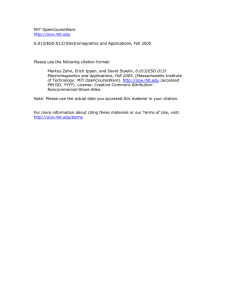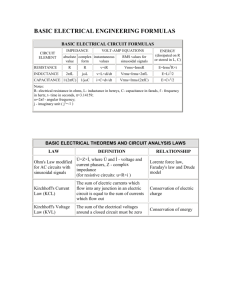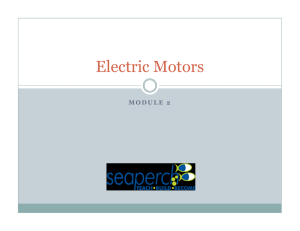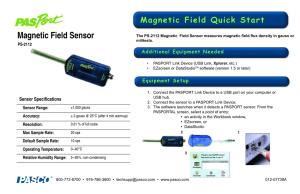Magnetic Force and Field Magnetic Field
advertisement
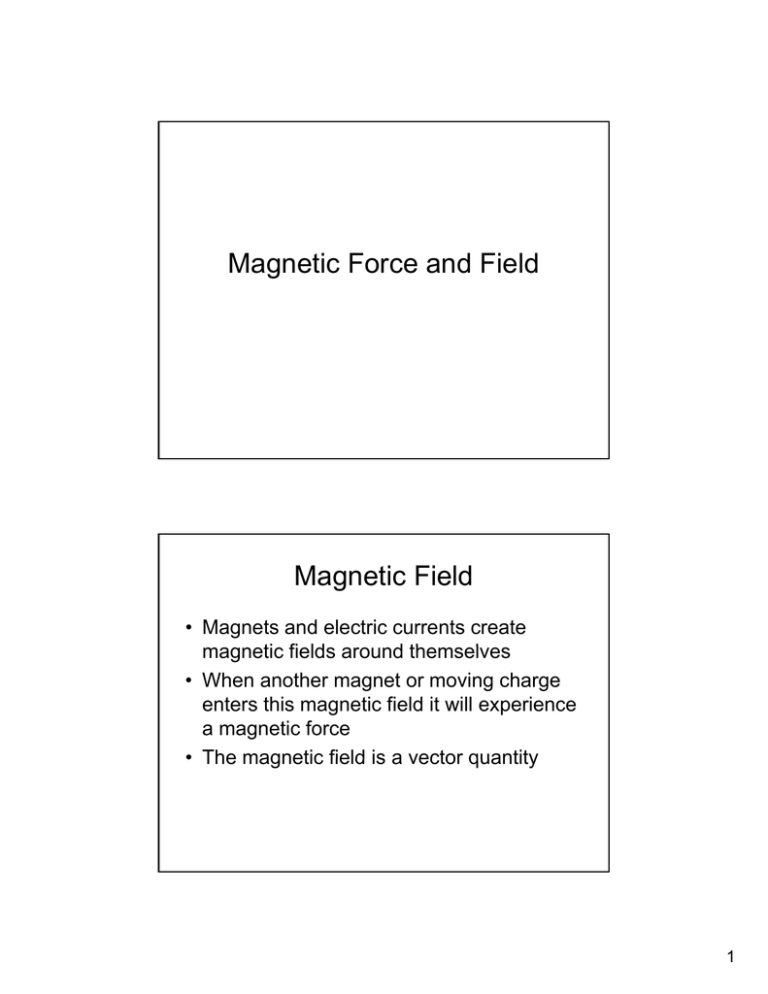
Magnetic Force and Field Magnetic Field • Magnets and electric currents create magnetic ti fifields ld around d th themselves l • When another magnet or moving charge enters this magnetic field it will experience a magnetic force • The magnetic field is a vector quantity 1 Magnetic Field Lines • Imaginary lines around magnets and currents t • Tangents to the field lines give the direction • Field lines go from “North” to “South” Permanent Magnet 2 Solenoid (Coil) Single Loop of Wire 3 Straight Wire Other Information • The magnetic field of the earth resembles that of a bar magnet except that the bar magnet does not coincide with the line through the geographic north and south poles of the earth. • A monopole p is an isolated north or south pole – Predicted by modern theories of particle physics but have never been found 4 Magnetic Force on Current • If a current is placed in a region of magnetic ti fifield, ld it will ill experience i a magnetic force. • The magnitude of the force is proportional to the current, I, the magnetic field magnitude, B, and the length L of the wire tthat at iss in the t e magnetic ag et c field. ed F = BIL sin θ θ is the angle between the current and the direction of the magnetic field 5 Direction of Magnetic Force On a Wire • Using the right hand, place the thumb in th di the direction ti off th the currentt and d th the fifingers in the direction of the magnetic field. • The direction away from the palm is the direction of the magnetic force. Magnetic Force on a Moving Charge • A moving charge will experience a magnetic ti fforce • A charge q moving with speed v in a magnetic field of magnitude B will experience a force F given by F = qvB B sin i θ Where θ is the angle between the direction of the velocity and the magnetic field 6 Direction of Magnetic Force on a Moving Charge • Using the right hand, place the thumb in th di the direction ti off th the velocity l it and d th the fifingers in the direction of the magnetic field. • The direction away from the palm is the direction of the magnetic force on a positive charge. Motion of Charges in Magnetic Fields • The magnetic force on a charge is always normall tto the th velocity l it • Therefore, the path of a charge in a magnetic field must be a circle 7 • Consider a charge q moving with speed v in a magnetic field B. • Assuming the charge’s velocity is normal g field,, the force on the to the magnetic charge is F = qvB v2 And so by Newton’s second law: qvB = m R Therefore… mv R= qB Work Done and Magnetic Forces • Since the magnetic force is always normal t the to th velocity l it off the th charge h • It cannot do any work • The big magnets in particle accelerators are used only to deflect particles not to increase the particles’ particles kinetic energy – Electric fields are used to increase the kinetic energy of the particles 8 Ørsted’s Discovery • The magnitude of the magnetic field B created t d by b th the currentt iin a wire i varies i linearly with the current in the wire and inversely with the perpendicular distance from the wire. μ I B= o 2π r μo is the magnetic permeability of free space μ = 4π x 10 −7 TmA −1 o Units • • • • The unit of the magnetic field is the tesla (T) The tesla is a big unit The magnetic field of the earth is about 10-4 T A wire carrying a current of about 2000 A produces a magnetic field of 8 x 10-5 T at a distance of 5 m from the wire 9 Direction of Magnetic Fields • The direction of the magnetic field at a given i point i t iin space iis ffound db by placing l i magnetic needles around the wire and seeing they align themselves “Right-hand Rule” • Grip the wire with the fingers of the right h d iin such hand h a way th thatt th the th thumb b points i t in the direction of the current • Then the direction in which the fingers curl is the direction of the magnetic field 10 Single Current Loop • The magnetic field strength B at the center off a circular i l lloop off radius di R carrying i current I is B= μo I 2R 11 The Solenoid • In the interior of the solenoid, the magnetic field is uniform in magnitude and direction B = μo NI L N is the number of turns L is the length of the solenoid I is the current through it 12 The Force Between Two Current-carrying Wires • Consider two long, straight, parallel wires each carrying a current, I1 and I2 • The first wire (wire 1) creates a magnetic field in space at the position of the second wire (wire 2) • Thus, Thus wire 2 will experience a magnetic force • Similarly, wire 2 will produce a magnetic fi ld att th field the position iti off wire i 1 • So wire 1 will also experience a magnetic force • Newton’s third law tells us that these forces should be equal and opposite 13 • If the currents run in the same direction, the forces are attractive • If the currents are in the opposite direction, the forces are repulsive 14 The magnetic fields generated by the wires separated by a distance r are given by I1 2πr I B2 = μ o 2 2πr B1 = μ o The forces on the wires can be calculated as follows: F2 = B1 I 2 L F2 = μ o I1 I2L 2πr F1 = B2 I1 L F1 = μ o I2 I1 L 2πr The forces are eq equal al in magnit magnitude de consistent with Newton’s third law 15 Side Note • The ampere is defined through the magnetic ti fforce b between t ttwo parallel ll l wires. i • If the force on a 1 m length of two wires that are 1 m apart and carrying equal currents is 2 x 10-7 N, then the current in each wire is defined to be 1 A. 16
